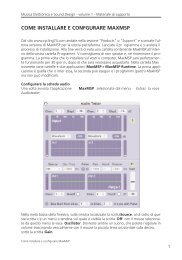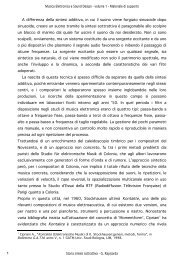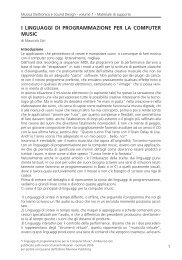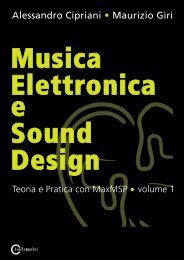programming with max/msp - Virtual Sound
programming with max/msp - Virtual Sound
programming with max/msp - Virtual Sound
You also want an ePaper? Increase the reach of your titles
YUMPU automatically turns print PDFs into web optimized ePapers that Google loves.
Electronic Music and <strong>Sound</strong> Design - Introduction<br />
INTRODUCTION<br />
This is the first of a series of three volumes dedicated to digital synthesis and<br />
sound design. The second volume will cover a range of additional topics in the<br />
realm of sound synthesis and signal processing, including dynamics processing,<br />
delay lines, reverberation and spatialization, digital audio and sampled sounds,<br />
MIDI, OSC and realtime synthesis. The third volume will be concerned <strong>with</strong> nonlinear<br />
techniques (such as AM and FM synthesis), granular synthesis, analysis<br />
and resynthesis, convolution, physical modeling, micromontage, and computeraided<br />
composition.<br />
PREREQUISITES<br />
This first volume will be useful to several levels of reader. Prerequisites for<br />
its study are minimal, and include nothing more than rudimentary musical<br />
knowledge such as an understanding of notes, scales, and chords, as well as<br />
basic computer skills such as saving files, copying and pasting text.<br />
The volume should be equally useful for self-learners and for those studying<br />
under the guidance of a teacher. It is laid out as chapters of theoretical background<br />
material that are interleaved <strong>with</strong> chapters that contain practical computer<br />
techniques. Each pair of chapters stands together as a unit. We suggest<br />
that curricula follow this structure, first touching on theory, then following up<br />
<strong>with</strong> hands-on material, including computer activities. The theoretical chapters<br />
are not intended to substitute for more expansive texts about synthesis; they<br />
provide, instead, an organic framework for learning the theory that is needed to<br />
invent sounds on the computer and to write signal processing programs.<br />
TIME NEEDED FOR STUDY<br />
The time needed for this material will, of course, vary from person to person.<br />
Nonetheless, here are two estimates to help in planning, one for learning under<br />
the guidance of an expert teacher, and the other for self-learners:<br />
Self-learning<br />
(300 total hours of individual study)<br />
Chapters Topic Total hours<br />
1T+1P+IA <strong>Sound</strong> synthesis 100<br />
2T+2A Additive Synthesis 60<br />
3T+3P+IB Subtractive Synthesis and Filtering 110<br />
4T+4P Control Signals 30<br />
Teacher-assisted learning<br />
(60 hours of classroom-based learning + 120 hours of individual study)<br />
Chapters Topic Lessons Feedback Studio time Total hours<br />
1T+1P+IA <strong>Sound</strong> synthesis 16 4 40 60<br />
2T+2P Additive Synthesis 10 2 24 36<br />
3T+3P+IB Subtractive Synthesis 18 4 44 66<br />
4T+4P Control Signals 5 1 12 18<br />
from “Electronic Music and <strong>Sound</strong> Design” Vol. 1 by Alessandro Cipriani and Maurizio Giri<br />
© ConTempoNet 2010 - All rights reserved<br />
IX







